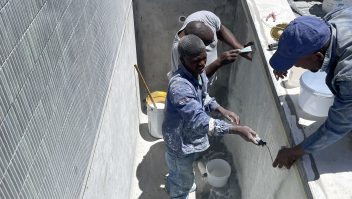A Step-by-Step To Replace Pool Pump Shaft Seal Guide for Cape Town Pool Owners
A leaking pool pump can waste water, reduce filtration efficiency, and damage your motor over time. In most cases, the culprit is a worn or damaged pool pump shaft seal. Replacing it may sound intimidating, but with the right guidance, it’s a manageable DIY task—or a quick fix by a professional pool technician. In this guide, we’ll walk you through how to replace a shaft seal, what tools you need, and when it’s best to call the experts.
Whether you’re doing pool pump repairs in Cape Town or looking for pool maintenance tips, this article is packed with helpful info.
What Is a Pool Pump Shaft Seal?
A shaft seal is a small mechanical component located between the motor and the impeller of your pool pump. Its job is to keep water from leaking into the electric motor. Over time, wear and tear from high water pressure, heat, or chemicals like chlorine can cause the seal to fail.
Signs you need a new seal:
- Water leaking beneath the pump
- Corrosion or rust around the motor shaft
- Unusual pump noise or reduced suction
Tools & Materials You’ll Need
- Replacement shaft seal (check your pump model)
- Socket set or wrench
- Flathead screwdriver
- Pliers
- Silicone-based lubricant
- Clean cloths or rags
Optional: Pool pump gasket kit (if gaskets look worn)
Step-by-Step Guide: Replacing a Pool Pump Shaft Seal
Step 1: Shut Off Power & Drain the Pump
Before any repairs, switch off the circuit breaker to prevent electrical accidents. Disconnect the pump and drain it fully.
Step 2: Disassemble the Pump Housing
Using your socket set, remove the bolts on the pump housing. Carefully separate the motor section from the impeller housing. Take note of the order and placement of parts.
Step 3: Remove the Impeller
Hold the motor shaft steady with a wrench and unscrew the impeller. Be gentle to avoid damaging the threads.
Step 4: Access & Remove the Old Shaft Seal
The shaft seal has two parts: one on the impeller and one in the pump housing. Remove both with a screwdriver or pliers. Clean the area thoroughly.
Step 5: Install the New Shaft Seal
Lubricate the new seal with silicone lubricant (not petroleum-based). Press the new ceramic ring into the housing and slide the spring-loaded half onto the impeller.
Step 6: Reassemble the Pump
Reattach the impeller and motor assembly. Ensure all O-rings and gaskets are in place. Bolt the housing back together.
Step 7: Reconnect & Test
Reconnect power and check for leaks. Run the pump for 10–15 minutes to ensure a watertight seal.
When to Call a Professional
If you’re unsure about the process or if the motor or impeller is corroded, it’s best to hire a pool repair specialist. At Pools Reno, we offer expert pool pump installations, repairs, and leak detection services in Cape Town and surrounding areas like Brackenfell, Durbanville, and the Atlantic Seaboard.
Internal Links
- How to Prime Your Pool Pump Like a Pro
- Pool Pump Installation Guide: Step-by-Step
- Common Pool Pump Problems and How to Fix Them
External Resources
Frequently Asked Questions
Q: How often should I replace my pool pump shaft seal?
A: On average, every 3–5 years depending on usage and water chemistry.
Q: Can I use petroleum jelly to lubricate the seal?
A: No. Use a silicone-based lubricant to avoid damaging the seal materials.
Q: My pump is still leaking after replacing the seal. What now?
A: Check for cracks in the housing or worn O-rings. You may also need to replace the impeller or motor shaft.
Q: How much does it cost to replace a shaft seal in South Africa?
A: DIY kits cost between R150 – R400, while professional service may range from R750 – R1,500, depending on location and pump type.
Need Help With Pool Pump Repairs in Cape Town?
If DIY isn’t your style or the problem seems more serious, contact Pools Reno for reliable and affordable pool pump repair services. We specialize in pump installations, pool plumbing, and ongoing pool maintenance plans throughout Cape Town.
👉 Book your repair today and keep your pool in perfect shape!



